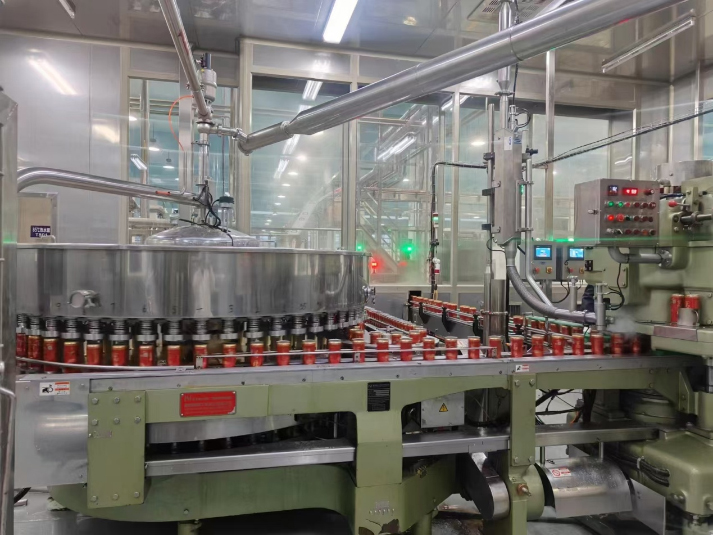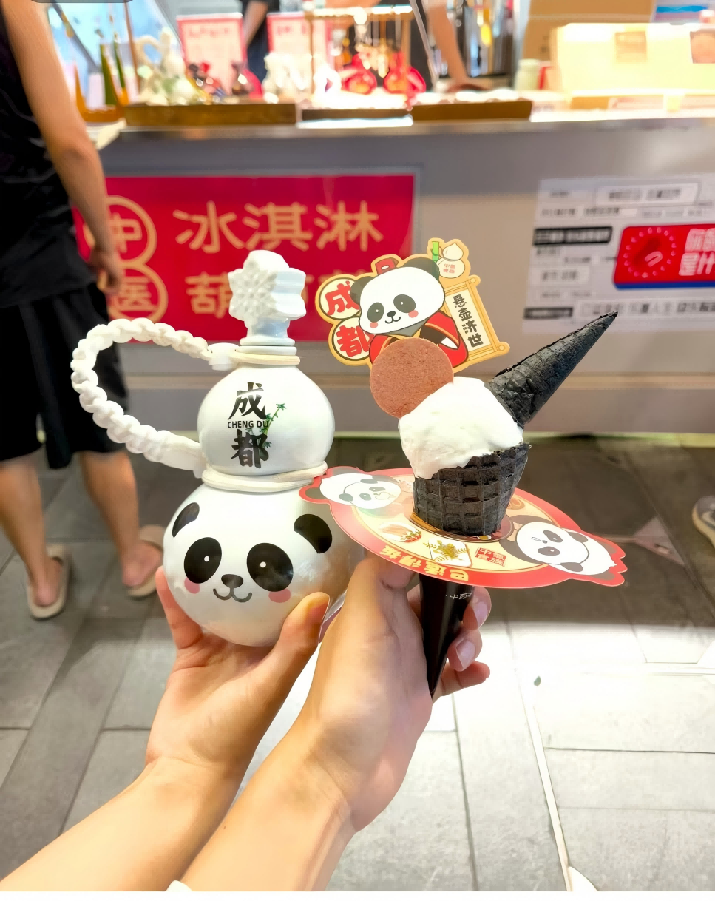| China |
| From roots to remedies | |
|
|
 The packaging line of a factory producing kudzu root drinks in Hengfeng County, Jiangxi Province, on August 5 (COURTESY PHOTO)
Kudzu root, when steamed, has a pleasantly sweet flavor and possesses remarkable medicinal properties. Its medicinal value has been recorded in the Bencao Gangmu (Compendium of Materia Medica), a monumental encyclopedia of traditional Chinese medicine (TCM) compiled by Ming Dynasty (1368-1644) physician Li Shizhen over 27 years—and finally published in 1593. The work documents 1,892 healing substances, including the root of kudzu (Pueraria lobata), a versatile vine native to Asia. Li classified the root as both food and medicine, noting its power to cool the body (reduce fevers or heatstroke symptoms), manage thirst and excessive urination (similar to modern diabetes care), and serve as a nutritious starch (be ground into flour for cakes, noodles or porridge). This "dual identity" exemplifies the ancient Chinese philosophy of "medicinal food homology," where nourishment and healing are achieved together, and one's daily diet becomes a preventive health regimen. Jiangxi Province's Hengfeng County is reputed as China's "home of kudzu," where the tradition of eating kudzu root dates back millennia. As early as the Tang (618-907) and Song (960-1279) dynasties, locals harvested wild kudzu roots, slicing them for herbal soups or pounding the starch into chewy flatbreads. "Kudzu's history in Jiangxi dates back 1,800 years. For centuries,kudzu has played a dual role in Chinese culture—valued equally as a healing herb in TCM and as a nutritious staple in daily cuisine," Dong Huanhuan, a professor at Jiangxi University of Chinese Medicine, told Beijing Review. "Today, advancements in agricultural processing and logistics have boosted its popularity as a modern health food." "Especially in recent years, TCM-inspired foods, low in calories and rich in wellness benefits, have gained traction among young consumers. This also indicates people's increasing health awareness and confidence in TCM," he added. Today, people in Jiangxi have transformed kudzu into modern formats—fine powders, herbal teas and wellness tonics, blending ancient wisdom with contemporary lifestyles. Kudzu-derived products from Jiangxi, ranging from pastries to ready-to-drink beverages, are also available in supermarkets across China.  Ice-cream infused with traditional Chinese medicine herbs on super popular lifestyle and e-commerce app RedNote on August 5 (SCREENSHOT)
Rising popularity For centuries, kudzu root, with its cooling, sweet and slightly pungent properties, has traditionally been prized for its antioxidant and detoxifying effects. It has also been used to treat measles, rashes and diarrhea, and plays a restorative role in stroke recovery by enhancing circulation. It is typically administered in doses of 9 to 15 grams. Modern science now validates that its compound, puerarin, not only improves cardiovascular function but also demonstrates remarkable metabolic benefits—lowering blood sugar, reducing cholesterol and shielding the liver from damage. "Jiangxi boasts excellent kudzu resources, not only because locals have a millennium-long history of planting and processing it, but also because, based on our tests, Jiangxi kudzu root contains higher levels of puerarin and other isoflavonoids (plant-derived compounds that can mimic estrogen activity in mammals), compared with other producing regions, making it particularly nourishing and suitable for beverage production," Dong said. He added that Jiangxi's kudzu products and raw materials are also highly popular overseas. Many manufacturers from the Republic of Korea and Japan purchase the raw materials to produce snacks and pastries. In recent years, with the continuing spread of TCM culture, Jiangxi's kudzu has also been exported to Europe and the United States. Today, Hengfeng cultivates approximately 1,333 hectares of kudzu, with annual output reaching 30,000 tons. The county has introduced over 30 kudzu-based products to the market, including noodles and tea, generating annual sales revenue of about 580 million yuan ($80 million). Ruibeifu (Jiangxi) Beverage and Food Co. Ltd., a leading kudzu processing enterprise based in Hengfeng, has established China's largest kudzu product processing base. With an annual processing capacity of 20,000 tons of roots, the company expects to generate 1.8 billion yuan ($250 million) in output value every year at full operation capacity. "Regardless of the product, integrating TCM is never as simple as just mixing herbs into drinks or food," he emphasized. "We strictly control the quality and quantity of medicinal ingredients, along with precise flavor profiling, to ensure both efficacy and palatability." In 2021, the National Health Commission (NHC) issued the regulations on substances that serve as both food and TCM materials, establishing a dynamic adjustment mechanism and management framework for dual-use substances. "Currently, China has implemented stringent regulations on food and beverage products that contain TCM ingredients," Dong explained. "For instance, manufacturers are prohibited from advertising the medicinal effects of functional ingredients on packaging or in marketing materials, given these products are classified as foods, not drugs." "Regulations continue to evolve accordingly, keeping pace with both technological advancements in the industry and shifting consumer preferences," Dong added. Broader food fashions Beyond Jiangxi's renowned kudzu root, provinces across China are embracing the fusion of TCM and cuisine, transforming local medicinal herbs into fresh food products and fueling a nationwide wave of wellness-focused consumption. As of November 2023, the NHC had expanded its list of dual-use substances to 102 entries. These include commonly used herbs like clove, Chinese yam, hawthorn, goji berries and cassia seed, which are being creatively incorporated into beverages, snacks, and even baked goods. Many time-honored TCM pharmacies and hospitals have introduced herbal teas and medicinal foods. Time-honored brands and establishments in China refer to those over 100 years old with unique traditions. Beijing's Baita Temple Pharmacy has embraced seasonal trends by blending loquat and pear juice into coffee, creating the loquat-pear latte. Meanwhile, the First Affiliated Hospital of Tianjin University of Traditional Chinese Medicine has launched health-boosting bread infused with astragalus root, which helps to, for example, ward off colds. Beijing Tong Ren Tang Traditional Chinese Medicine Hospital has also introduced its own line of herbal breads. Another popular product from Tong Ren Tang, one of China's most prestigious TCM brands, is the Night Owl Elixir, a bestseller among young consumers. This herbal drink blends ginseng slices, monk fruit, jujube, chrysanthemum and honey—ingredients traditionally used in TCM to combat fatigue and replenish energy. Additionally, some restaurants now serve medicinal dishes, such as angelica mutton soup and goji berry stewed chicken, to cater to customers' health needs. Seasonal tastes have also caught up with the trend. Ice cream infused with herbal ingredients, developed by the Heilongjiang Academy of Chinese Medicine is the latest fad. Containing medicinal components like lingzhi (Reishi mushroom), Siberian ginseng leaves and the medicinal fungus Poria cocos, the unique dessert first went viral as a must-try on the Central Street in Harbin, Heilongjiang's provincial capital, with people flocking to the area to get a taste. Now, the brand has expanded with new outlets in Jilin, Shandong, Guangdong and Sichuan provinces. "Combining TCM with everyday foods is nothing new. When I was a child, my grandparents often steeped dried tangerine peel and goji berries in water for me to drink. In autumn, we'd have pear syrup paste to soothe our throats," 24-year-old Beijing resident Li Rui told Beijing Review. "But what's noteworthy in recent years is how well TCM foods have been commercialized," she added. "As consumers, we're not choosing TCM foods to cure illnesses—it's more about cultivating wellness habits and preventing diseases. Plus, products developed by hospitals or in collaboration with medical research institutes give us a sense of safety and trust." (Reporting from Jiangxi Province) Copyedited by Elsbeth van Paridon Comments to zhangyage@cicgamericas.com |
|
||||||||||||||||||||||||||||
|